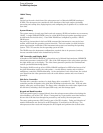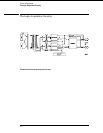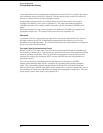
RAM Test
The RAM test checks the video RAM (VRAM), system dynamic RAM (DRAM), and static RAM
memory within the real time clock IC. The microprocessor first performs a write/read in each
memory location of the VRAM. At each VRAM memory location a test pattern is written, read,
and compared. An inverse test pattern is then written, read, and compared. After verifying
correct operation of the VRAM, the System RAM and real time clock RAM are tested in a
similar fashion.
Passing the RAM test implies that the microprocessor can access each VRAM memory location
and that each VRAM memory location can store a logical "1" or a logical "0." If the VRAM is
functioning properly, the logic analyzer can construct a correct, undistorted display. Passing
the RAM test also implies that the memory locations of system RAM can be accessed by the
microprocessor and the data in RAM is intact, and that the memory locations inside the real
time clock IC can store a logical "1" or a logical "0."
Interrupt Test
The Interrupt Test checks the microprocessor interrupt circuitry. With all interrupts disabled
from their source, the microprocessor waits for a short period of time to see if any of the
interrupt lines are asserted. An asserted interrupt line during the wait period signifies
incorrect functioning of the device generating the interrupt or the interrupt circuitry itself.
Those interrupts that can be asserted under software control are exercised to verify
functionality.
Passing the Interrupt Test implies that the interrupt circuitry is functioning properly. Passing
the Interrupt Test also implies that the interrupt generating devices are also functioning
properly and not generating false interrupts. This means that the microprocessor can execute
the operating system code and properly service interrupts generated by pressing a front panel
key or receiving an GPIB or RS-232C command.
System Tests (System PV)
The system tests are functional performance verification tests. The following describes the
system tests:
ROM Test
The ROM test performs several checksum tests on various read only memory elements,
including the system ROM.
Passing the ROM test implies that the microprocessor can access each ROM memory address
and that each ROM segment provides checksums that match previously calculated values.
RAM Test
The RAM test performs a write/read operation in each memory location in system dynamic
RAM (DRAM). The video RAM in the display subsystem and the acquisition RAM in the data
acquisition subsystem are not tested as part of the RAM test and are tested elsewhere. At
each DRAM memory location, the code that resides at that location is stored in a
microprocessor register. A test pattern is then stored at the memory location, read, and
compared. An inverse test pattern is then stored, read, and compared. The original code is
then restored to the memory location. This continues until all DRAM memory locations have
been tested. The static RAM in the real time clock chip is also tested in a similar fashion.
Passing the RAM test implies that all RAM memory locations can be accessed by the
microprocessor and that each memory location can store a logical "1" or a logical "0."
Theory of Operation
System Tests (System PV)
8–10


















